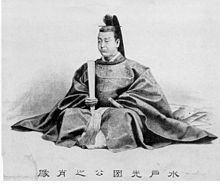Tokugawa Mitsukuni
Tokugawa Mitsukuni ( Japanese 徳 川 光 圀 ; * July 11, 1628 , † January 14, 1701 ) was the third son of Tokugawa Yorifusa , the founder of the Mito family of the Tokugawa - Gosanke . Due to his talent, Mitsukuni was chosen as his successor. Through his wise government, the publication of historical work Dai Nihon shi ( "History of Great Japan") and the establishment of the school of philosophy mitogaku , it projects under the Mito - Prince forth.
Live and act
Naming
His childhood name ( yōmyō ) was Chōmaru ( 長 丸 ), then Chōmatsu ( 千代 松 ), on the occasion of growing up ( genpuku ) then Mitsukuni ( 光 国 ). His nickname ( azana ) was initially Tokuryō ( 徳 亮 ) or Kanshi ( 観 之 ), later Shiryū ( 子 龍 ). His author's name ( gō ) was Nisshinsai ( 日新 斎 ), Jōzanjin ( 常山 人 ), Sotsuzenshi ( 率然 子 ), from the last years of his life Bairi ( 梅里 ), Seizan ( 西山 ) are particularly well known. His honorary name as Gon-Chūnagon was Kōmon ( 黄 門 ), his posthumous name ( okurina ) Gikō ( 義 公 ).
Youth and Studies
Mitsukuni was born in the residence of the vassal Miki Yukitsugu, mother was Tani Hisako, a concubine of Yorifusa. It was not until he was five years old that he was recognized by his father and, because of his talent, appointed as his successor. Mitsukuni came to the Mito residence in Edo in 1633 and grew up there.
He used the 28 years until he took over the fiefdom ( Han ) in 1661 to educate himself. At the age of 18 he studied the Baike-den ( 伯夷 伝 ) from Shiki ( 史記 ), which motivated him to deal with history. At the age of 27 he married Taihime, daughter of the former Kampaku Konoe Nobuhiro , but at the age of 31 he lost his wife, but did not remarry.
Immediately after the great Meireki fire in 1657, he set up a study site for history in the secondary residence in Komagome. That was the beginning of the systematic preoccupation with history.
Time as a daimyo
In 1662, at the age of 34, he took over the management of the Han. During this time, the improved water supply through the Kasahara Canal ( 笠原 水道 , Kasahara suidō ) was set up, burial sites for samurai were built, temples and shrines were relocated to the outskirts because of the risk of fire and the castle town of Mito was put in order. The place of study for history was moved to the main residence Koishikawa and was given the name Shōkōkan ( 彰 考, ), scientists from all over Japan were invited to collaborate. In 1690, Mitsukuni left the management of the Han to his nephew Tsunaeda ( 綱 條 , 1656-1718), the son of the older brother Matsudaira Yorishige (Daimyō in Takamatsu ), but supported him in his work.
The last decade
A year after retiring from office, Mitsukuni had a country house built in the north of Mito in the mountains on the edge of Ōta ( Hitachi ) and lived there until his death. He was primarily concerned with the completion of the historical work, built a second Shōkōkan inside the Mito residence and now gathered the scholars there. Japanese history, the separation of Buddhism and Shinto were subjects that were later dealt with in more detail as subjects of the Mito school . Mitsukuni traveled a lot in the Han in order to get to know the concerns of the people firsthand and took care of the development of cultural goods, for example the preservation of the Nasukokuzō no hi ( 那 須 国 造 碑 ) memorial stone .
Mitsukuni in the media
In the Meiji and Taishō period , Mitsukuni was known in books as Mito Kōmon ( 水 戸 黄 門 ). Later, Japanese television broadcast series about him, how he moves undetected among the people and, if necessary, intervenes and finds just solutions to problems.
Remarks
- ↑ traditional : Genroku 13/12/6. Since Genroku 13 largely corresponds to the year 1700, this is often given as the year of death. However, the 12th lunar month began in January 1701.
- ↑ 「光 圀」 he wrote himself after he was fifty years old.
- ↑ Early Chinese History.
- ↑ Today the Faculty of Agriculture of Tokyo University is located there.
- ↑ For example "House of Shining Thought".
literature
- Seya, Yoshihiko: Tokugawa Mitsukuni. In: Suzuki, Toshihiko (ed.): NIhon daihyakka zensho (Denshibukku-han) , Shogakukan, 1996.
Web links
| personal data | |
|---|---|
| SURNAME | Tokugawa, Mitsukuni |
| ALTERNATIVE NAMES | 徳 川 光 圀 (Japanese) |
| BRIEF DESCRIPTION | Japanese daimyo |
| DATE OF BIRTH | July 11, 1628 |
| DATE OF DEATH | January 14, 1701 |

